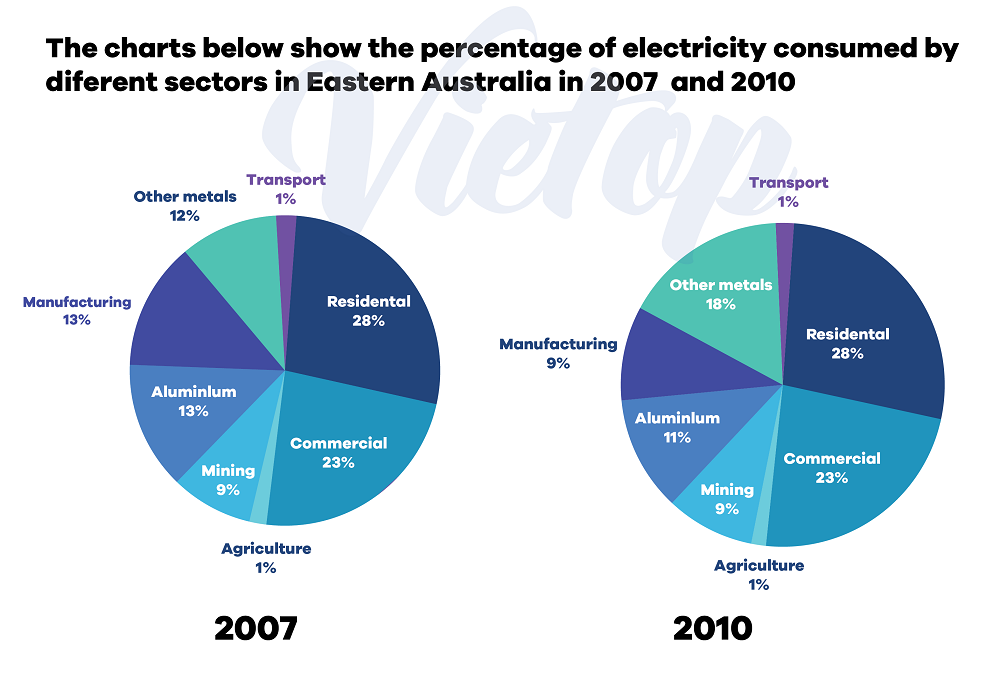Đề luyện tập IELTS Writing số 7: Use the power of other fields in East Australia & Tourism discussion
Tiếp nối chuyên mục mỗi tuần một bài ôn luyện thì hôm nay IELTS Vietop gửi đến các sĩ tử đề luyện tập IELTS Writing số 7: Use the power of other fields in East Australia & Tourism discussion, xem và lưu lại những điểm nổi bật để ôn luyện nhé!
Task 1
Đề bài
The pie charts illustrate electricity use by various fields in Eastern Australia between the years 2007 and 2010.

Sample
In general, except for Aluminium, Manufacturing, and Other Metal Fields, the use of power from those sectors remained steady over the period indicated. Meanwhile, the numbers for the residential and commercial sectors were by far the most significant.
Residential areas consumed over a quarter of total electricity in 2007, while commercial areas were slightly behind. Manufacturing and the aluminum industry both used 13 percent of total electricity, while other metals and mining consumed somewhat less, at 12 percent and 9%, respectively. Transport and agriculture, on the other hand, accounted for only a small percentage of total electricity usage.
While the amount of power consumed by other metals increased by 6% in 2010, the percentages consumed by aluminum and industrial areas decreased relatively to around merely a tenth of the total. Surprisingly, the proportions of electricity consumption by the other industries matched the initial figures.
Xem thêm bài viết: Hướng dẫn cách viết dạng Pie Chart – IELTS Writing Task 1
Vocab
- Remain steady (v): duy trì sự ổn định
- match the initial figure (v): duy trì số liệu như thời điểm ban đầu
Task 2
Đề bài
Tourism is one of the world’s largest and fastest-growing sectors, as the world is more linked than it has ever been. The scenario helps people to learn about the culture, history, and customs of people in various regions of the world, but it also causes uncertainty and animosity between countries. The supplied thought appears to be controversial at first glance and thus necessitates the comprehensive deliberation outlined in the following paragraphs.
Sample
To begin with, tourism plays a critical part in a country’s economic development, as it contributes to the advancement of individuals, societies, and governments in a variety of ways. Individually, it assists them in providing job possibilities and employs a huge number of both qualified and unskilled workers. For business people, it facilitates the expansion of their hotels, which in turn fosters national integration and generates foreign exchange for the government. Furthermore, it aids the expansion of the local industry, which primarily deals in handicrafts and hand-made objects that provide tourists with insights into the local culture and history.
On the other hand, some people believe that tourism promotes tension rather than learning a country’s people and culture. In this regard, some tourists are unfamiliar with the local culture, history, and traditions of the country in question, and they attempt to comprehend them in ways that are offensive to the local people. Tensions and conflicts arise as a result of the aforementioned discrepancies between two communities. For example, when foreigners visit sacred sites, they would accidentally have behaviors considered as being disrespectful to the deities and make fun of the holy site. Furthermore, a foreign language might as well create a barrier and lead to miscommunication.
To summarize, the tourism industry is an important aspect of a country’s economic growth and helps to infuse foreign currency into the economy; yet, it should be managed carefully to avoid any confusion and contempt for local people’s sentiments and traditions.
Xem ngay: Cách miêu tả một luận điểm tốt – IELTS Writing Task 2
Vocab
- sentiment (n): sự nhạy cảm
- discrepancy (n): sự chênh lệch, sự khác biệt
- animosity (n): sự phản đối mạnh mẽ quá mức
- foster (v): cải thiện, tăng cường
- national integration (n): sự gắn kết về mặt kinh tế nội địa
- foreign exchange (n): nguồn ngoại tệ
Trên đây là 2 bài mẫu IELTS Writing mà Vietop muốn gửi đến bạn. Hy vọng những chia sẻ trên sẽ giúp ích được bạn trong quá trình luyện thi IELTS. Nếu bạn thấy bài viết hữu ích hãy chia sẻ đến bạn bè để cùng ôn tập nhé!
source https://www.ieltsvietop.vn/tu-hoc-ielts/writing/de-luyen-tap-ielts-writing-so-7-use-the-power-of-other-fields-in-east-australia-tourism-discussion/
Nhận xét
Đăng nhận xét